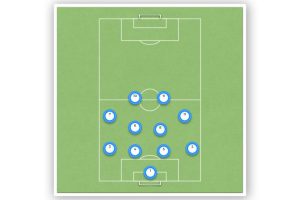Defend Against Wing Play Soccer Tactics: Tips and Strategies
As a soccer player, defending against wing play can be a challenging task. Wingers are often the fastest and most skillful players on the field, and their primary objective is to get behind the defense and create scoring opportunities. To defend effectively against wing play, you need to have a solid understanding of the tactics involved and the skills required to execute them.
One of the most critical aspects of defending against wing play is maintaining a strong defensive shape. As a defender, you need to be aware of your positioning and your teammates’ positioning at all times. This means staying compact and organized, with your backline and midfield working together to close down space and limit the wingers’ opportunities to get behind the defense.
Another essential tactic for defending against wing play is pressing the ball effectively. This means putting pressure on the opposing winger as soon as they receive the ball, forcing them to make quick decisions and limiting their time and space on the ball. By doing this, you can disrupt their rhythm and prevent them from building up momentum and creating scoring chances.
Defending Against Wing Play
Positioning and Communication
When defending against wing play, proper positioning and communication are crucial. As a defender, it is important to position yourself between the attacker and the goal, forcing them to go wide and limiting their options. Communicate with your teammates to ensure that everyone is aware of their defensive responsibilities and that there are no gaps in the defense. One effective strategy is to use a “near post” and “far post” defender. The near post defender covers the area closest to the goal, while the far post defender covers the opposite side. This helps to prevent attackers from getting behind the defense and scoring from a cross.
Individual Marking vs. Zonal Marking
There are two main types of marking when defending against wing play: individual marking and zonal marking. Individual marking involves assigning a defender to mark a specific attacker. This can be effective against skilled attackers who are difficult to defend against in a zonal system. However, it can also leave gaps in the defense if the marked player is able to draw defenders out of position. Zonal marking involves defenders covering specific areas of the field rather than individual players. This can be effective against teams that rely heavily on crosses or wide play. However, it requires good communication and coordination among defenders to ensure that all areas are covered. It is important to note that there is no one-size-fits-all solution when it comes to defending against wing play. The best approach will depend on the strengths and weaknesses of both the attacking and defending teams.
| Individual Marking | Zonal Marking | |
|---|---|---|
| Pros | Effective against skilled attackers | Effective against teams that rely on crosses or wide play |
| Cons | Can leave gaps in the defense | Requires good communication and coordination |
In conclusion, defending against wing play requires a combination of proper positioning, communication, and effective marking. By utilizing both individual and zonal marking strategies, defenders can limit the attacking team’s options and prevent them from scoring from crosses or wide play.
Stopping Crosses
Stopping crosses is an essential part of defending against wing play tactics in soccer. Here are some effective ways to prevent your opponents from delivering dangerous crosses into the box:
Pressing the Ball
When the opposing winger has the ball, the first line of defense is to press the ball and prevent them from getting a clear sight of the goal. As a defender, it’s important to stay tight to your opponent and force them to make a decision quickly. This can disrupt their rhythm and limit their options, making it harder for them to deliver an accurate cross.
It’s important to note that pressing the ball should be a team effort. As a defender, you should communicate with your teammates to ensure that everyone is coordinated and working together to close down space and limit the opposition’s options.
Blocking the Cross
Another effective way to stop crosses is to block them before they can be delivered. This requires good positioning, anticipation, and timing. As a defender, you should aim to get between the winger and the goal, and position yourself in a way that makes it difficult for them to get the ball past you.
One way to do this is to take a half-step back and position yourself in front of the winger’s strong foot. This can force them to either cut inside or play the ball backwards, giving your team a chance to regain possession.
Clearing the Ball
If the opposition does manage to deliver a cross, it’s important to be prepared to clear the ball. This requires good awareness, timing, and technique. As a defender, you should aim to get into a good position to intercept the cross, and be prepared to head or kick the ball away from danger.
It’s important to communicate with your teammates and ensure that everyone is on the same page. This can help to prevent confusion and ensure that the ball is cleared effectively.
| Pressing the Ball | Blocking the Cross | Clearing the Ball |
|---|---|---|
| Stay tight to your opponent | Position yourself in front of the winger’s strong foot | Get into a good position to intercept the cross |
| Force them to make a decision quickly | Take a half-step back | Be prepared to head or kick the ball away from danger |
| Communicate with your teammates to ensure everyone is coordinated | Get between the winger and the goal | Ensure that everyone is on the same page |
Counterattacking Opportunities
When defending against wing play, it’s important to not only focus on defending, but also to look for counterattacking opportunities. Here are a couple of ways to exploit space and quickly transition from defense to attack:
Exploiting Space Behind the Wingback
One way to counterattack against wing play is to exploit the space behind the wingback. When the wingback pushes forward to support the attack, there is often a large gap between the wingback and the center back. This gap can be exploited by a quick pass or a long ball to a forward who can run into the space behind the wingback.
It’s important for the midfielders and forwards to recognize this opportunity and make runs into the space behind the wingback. The timing of the run is crucial, as the pass needs to be played at the right moment to catch the defense off guard.
Quick Transitions
Another way to counterattack against wing play is to quickly transition from defense to attack. When the opposition loses possession of the ball, the defenders should look to quickly play the ball forward to the midfielders or forwards who are making runs into space.
It’s important for the midfielders and forwards to be aware of this opportunity and make runs into space as soon as the ball is won. The quicker the transition from defense to attack, the more likely the team is to catch the opposition off guard.
| Step | Action |
|---|---|
| 1 | Opposition loses possession of the ball |
| 2 | Defender quickly plays the ball forward to a midfielder making a run into space |
| 3 | Midfielder quickly passes the ball to a forward making a run behind the defense |
| 4 | Forward scores a goal |
By exploiting space behind the wingback and quickly transitioning from defense to attack, a team can create counterattacking opportunities and score goals against the opposition.
Conclusion
Defending against wing play is a crucial aspect of soccer tactics. As I have discussed in this article, there are several strategies that can be employed to effectively defend against wingers.
One of the most important strategies is to maintain a compact defensive shape, with the fullbacks and wingers working together to prevent the opposition from making progress down the wings. This can be achieved through effective communication and coordination between the players.
Another effective strategy is to apply pressure on the opposition wingers as soon as they receive the ball, forcing them to make a quick decision and potentially make a mistake. This requires players to be quick and decisive in their movements, and to work together as a team to apply pressure effectively.
Finally, it is important to be aware of the different types of crosses that wingers can deliver, and to position defenders accordingly to prevent dangerous crosses from reaching the opposition’s attackers. This requires a good understanding of the opposition’s tactics and the ability to adapt quickly to changing situations.
By employing these strategies, teams can effectively defend against wing play and prevent the opposition from creating dangerous scoring opportunities. However, it is important to remember that there is no one-size-fits-all solution, and that successful defending requires a combination of tactics, skill, and teamwork.







